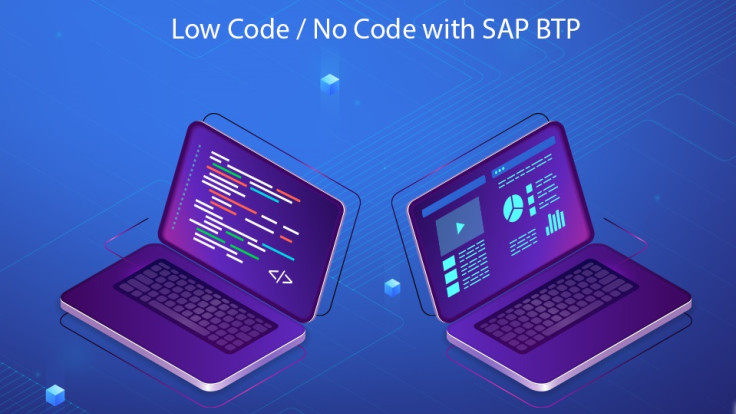No-Code & Low-Code in SAP BTP: Game Changer or Overhyped?
- Posted on March 5, 2025
- SAP
- By ROI Blogger
- 731 Views
SAP Business Technology Platform (BTP) is revolutionizing digital transformation with its no-code and low-code capabilities. These tools, including SAP AppGyver, SAP Build Apps, and SAP Build Process Automation, empower citizen developers to create applications without extensive coding knowledge. The blog explores the benefits of these platforms, such as accelerating development cycles, reducing costs, and enhancing business agility. However, it also addresses challenges like governance, security, scalability, and the complexity of enterprise-grade applications. The key to success lies in adopting a hybrid approach that combines no-code/low-code with traditional development, ensuring proper governance and support. By leveraging these tools strategically, businesses can drive innovation and stay competitive in the digital age.

The digital transformation imperative is pushing businesses to innovate faster than ever. In this context, SAP Business Technology Platform (BTP) has emerged as a crucial tool, offering a suite of services for integration, extension, and data management. Among the most talked-about features are its no-code and low-code capabilities, promising to democratize development and accelerate time-to-value. But is this a genuine game-changer, or just another overhyped trend?
Understanding the Landscape: No-Code and Low-Code Defined
Before diving into the debate, it's essential to clarify the terms. No-code platforms allow users to build applications and automate processes through visual interfaces, drag-and-drop functionalities, and pre-built components, requiring absolutely no coding knowledge. Low-code, on the other hand, provides a visual development environment but allows for some degree of custom coding for more complex functionalities.
In SAP BTP, these capabilities are primarily delivered through services like SAP AppGyver (no-code), SAP Build Apps (low-code), SAP Build Process Automation (low-code/no-code), and SAP Integration Suite’s pre-built integration flows and adapters.
The Promise of Democratization and Agility
The core appeal of no-code and low-code in SAP BTP lies in their potential to:
- Empower Citizen Developers: Business users, analysts, and domain experts, who possess deep knowledge of business processes but lack coding skills, can directly participate in application development and automation. This reduces reliance on scarce developer resources and fosters innovation from within.
- Accelerate Development Cycles: Visual interfaces and pre-built components significantly reduce the time required to develop and deploy applications. This allows businesses to rapidly prototype, iterate, and respond to changing market demands.
- Reduce Development Costs: By minimizing the need for extensive coding, no-code and low-code platforms can lower development costs and free up professional developers to focus on more complex and strategic projects.
- Enhance Business Agility: Faster development and deployment cycles enable businesses to adapt quickly to new opportunities and challenges, improving overall business agility and competitiveness.
- Simplify Integration: SAP Integration Suite provides pre-built integration flows and adapters, allowing for seamless connection between SAP and non-SAP systems without extensive coding.
The Reality Check: Addressing the Challenges
While the potential benefits are undeniable, the implementation of no-code and low-code in SAP BTP is not without its challenges:
-
Complexity of Enterprise-Grade Applications: While no-code and low-code are ideal for simple applications and automations, complex enterprise-grade applications often require custom coding and deep technical expertise. The limitations of visual interfaces and pre-built components may become apparent when dealing with intricate business logic and data structures.
-
Governance and Security: Empowering citizen developers raises concerns about governance, security, and compliance. Without proper controls and guidelines, there is a risk of creating shadow IT applications that may not meet security or regulatory requirements.
-
Scalability and Performance: Applications built with no-code and low-code platforms may face scalability and performance challenges when dealing with large volumes of data or complex transactions. Optimizing performance and ensuring scalability may require technical expertise that goes beyond the capabilities of citizen developers.
-
Integration Complexity: While SAP Integration Suite simplifies integration, connecting to legacy systems or third-party applications with complex APIs may still require custom coding and specialized knowledge.
-
Maintenance and Support: Maintaining and supporting applications built with no-code and low-code platforms can be challenging, especially as they grow in complexity. Ensuring consistency, reliability, and security requires ongoing monitoring and maintenance.
-
Vendor Lock-in: Heavy reliance on a specific no-code/low-code platform can lead to vendor lock-in, limiting flexibility and increasing dependence on a single provider.
-
The requirement of understanding SAP's data structure: While the coding is reduced, a firm understanding of SAP's core data models, and business processes is still required to create effective applications.
The Verdict: A Powerful Tool, Not a Silver Bullet
In conclusion, no-code and low-code in SAP BTP are undoubtedly powerful tools that can significantly accelerate digital transformation initiatives. However, they are not a silver bullet that can solve all development challenges.
They are a game-changer when used strategically for:
-
Rapid prototyping and proof-of-concept development.
-
Building simple applications and automations for specific business needs.
-
Empowering citizen developers to solve their own problems.
-
Streamlining integration and data management.
However, they are overhyped if considered as a replacement for professional developers or a solution for building complex enterprise-grade applications without any coding knowledge.
The key to success lies in adopting a hybrid approach that leverages the strengths of both no-code/low-code and traditional development. Organizations should:
-
Establish clear governance and security guidelines for citizen development.
-
Provide adequate training and support for citizen developers.
-
Focus on using no-code/low-code for appropriate use cases.
-
Integrate no-code/low-code with traditional development workflows.
-
Invest in building a strong foundation of SAP expertise.
By adopting a balanced and strategic approach, businesses can harness the full potential of no-code and low-code in SAP BTP to accelerate innovation, enhance agility, and drive digital transformation. The technology is here to stay, and its effective utilization will separate the leading companies from the rest.





Write a Response